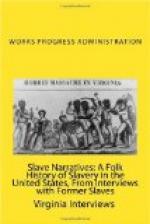“De white folks allus helped deir Niggers wid de weddin’s and buyed deir clothes for ’em. I ’members once a man friend of mine come to ax could he marry one of our gals. Marster axed him a right smart of questions and den he told him he could have her, but he mustn’t knock or cuff her ’bout when he didn’t want her no more, but to turn her loose.
“Us had a big cemetery on our place and de white folks allus let deir Niggers come to de fun’rals. De white folks had deir own sep’rate buryin’ ground, but all de coffins was home-made. Even de ones for de settlement peoples was made right in our shop. Yassum, dey sung at de fun’rals and you wants me to sing. I can’t sing, but I’ll try a little bit.” Then with a beautiful and peculiar rhythm only attained by the southern Negro, she chanted:
’Come-ye-dat-love-de-Lord
And-let-your-joys-be-known.’
“A rooster crowin’ outside your door means company’s comin’ and a squinch owl means sho’ death. Dose are all de signs I kin ’member and I don’t ‘member nothin’ ’bout slavery remedies.
“Yassir, dey useter give us a nickel or 10 cents sometimes so us could buy candy from de store.” Asked if she remembered patterollers she gave her sly chuckle and said: “I sho’ does. One time dey come to our house to hunt for some strange Niggers. Dey didn’t find ’em but I was so skeered I hid de whole time dey was dar. Yassir, de Ku Kluxers raised cain ’round dar too.
“I ’members de day well when Marster told us us was free. I was glad and didn’t know what I was glad ’bout. Den ’bout 200 Yankee soldiers come and dey played music right dar by de roadside. Dat was de fust drum and fife music I ever heared. Lots of de Niggers followed ’em on off wid just what dey had on. None of our Niggers went and lots of ’em stayed right on atter freedom.
“Four years atter dat, I left Edgefield and come here wid my old man. Us had six chilluns. My old man died six years ago right dar ’cross de road and I’se livin’ here wid my daughter. I can’t wuk no more. I tried to hoe a little out dar in de field last year and I fell down and I hasn’t tried no more since.
“I went once not so long ago to see my white folkses. Dey gived me a dollar to spend for myself and I went ’cross de street and buyed me some snuff—de fust I had had for a long time. Dey wanted to know if I had ever got de old age pension and said dat if I had been close to dem I would have had it ’fore now.”
[HW: Ex. Slv. #6]
[HW: Marshal butler]
Subject: Slavery Days And After
District: No. 1 W.P.A.
Editor and Research: Joseph E. Jaffee
Supervisor: Joseph E. Jaffee
[HW: (This copy has photog. attached.)]
Slavery Days And After
I’se Marshal Butler, [HW: 88] years old and was born on December 25. I knows it was Christmas Day for I was a gift to my folks. Anyhow, I’se the only niggah that knows exactly how old he be. I disremembers the year but you white folks can figure et out.




